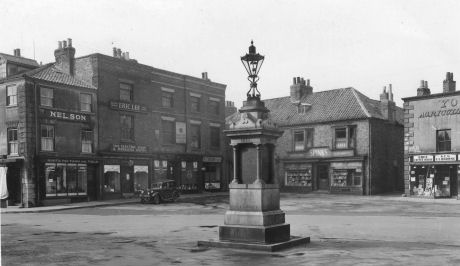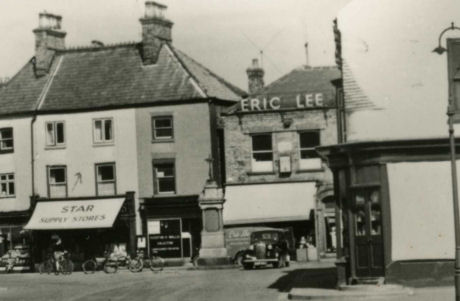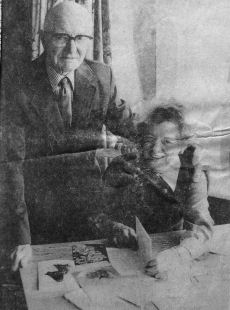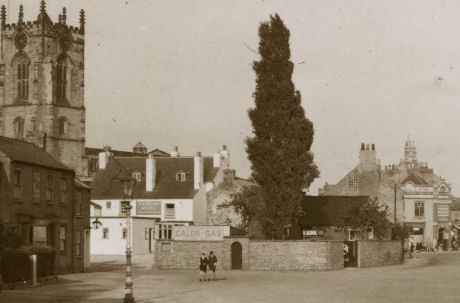|
The Pocklington Weekly News for 13th February 1904 reported that George Todd had purchased a generator and lit his shop by electricity from February 1904. Other tradesmen and wealthy residents followed his lead, but it was not until 1913 that the council negotiated for “the laying of an electricity mains to supply the whole town (UDC minutes)”. In fact, it is doubtful whether that main was ever laid. Allisons the builder, appear to have had a generator supplying the houses that they had built on the Algarth estate in the 1920s. Roger Bellingham told me his house on Garths End was built by Allisons around 1928 and it appears never to have had gas lighting.

Eric Lee started in Market Square in 1933 opposite where they are today
Nationally, in the 1920s about 6% of households had access to electricity. Following the Electricity (Supply) Act 1926 the National Grid was set up (completed in 1933) and electricity commissioners appointed who seem to have had power to allocate supply areas. Hull Daily Mail reported on 10th March 1933 that Major Carver, the MP for Howdenshire, had enquired when electricity was coming to Pocklington and was told that it was “in the area of the Buckrose Light and Power Company whose powers became operative in May 1931”. Eric Lees were established in 1933 to take advantage of this new technology.

Eric Lee's in 1960's
 The Lee family are an old Pocklington area family which dates back to the eighteenth century. Elsie Moore (from Everingham) and Eric Lee (from Pocklington) married in Hayton in 1930. Soon after they founded the electrical business in which they both worked until they retired in 1968. The business appears in the 1937 trade directory. (“Lee Eric, wireless apparatus dealer, electrical engineer, complete installations; relay service, Electric house & Radio stores, 45 Market place. T N 90”). The Lee family are an old Pocklington area family which dates back to the eighteenth century. Elsie Moore (from Everingham) and Eric Lee (from Pocklington) married in Hayton in 1930. Soon after they founded the electrical business in which they both worked until they retired in 1968. The business appears in the 1937 trade directory. (“Lee Eric, wireless apparatus dealer, electrical engineer, complete installations; relay service, Electric house & Radio stores, 45 Market place. T N 90”).
Right Picture: Eric & Elsie Lee at the occasion of their Golden Wedding anniversary in 1980.
No mention is made in the in Directory of a local office for Buckrose Light, they seem to have had their office in Driffield.
The Howdenshire Chronicle for 7th October 1933 reports:
`Electric Light at Pocklington – The inauguration ceremony in connection with the public supply of electricity in the town took place last Wednesday afternoon, when in opening of an exhibition of the various electrical devices and demonstrations of cooking. Councillor James Johnson, chairman of the Pocklington Urban District Council switched on the power which flooded the room with light, this action being greeted with applause by the large company present. Councillor Johnson was accompanied by H. Meynell, Mr. A. Alison and Mr. J.W. Fawcett, engineer of the company. Mr. J.W. Fawcett stated that in May 1931 the Buckrose Light and Power Co. obtained a special order to supply electricity to the greater part of Buckrose. Since that date supplies have been afforded to the town of Driffield and the villages of Hunmanby, Muston, Towthorpe, Nafferton, Leven, Cherry Burton, Etton and South Dalton and about a month ago to Market Weighton. Today Pocklington and ere long at Shipton and Hayton…. Councillor Johnson in switching on the power congratulated the company on their enterprise in bringing electricity to Pocklington. The company present would be rather surprised that the cost amounted to £20,000, which appeared an enormous amount, and the company deserved support for their enterprise (Applause). In looking over the pamphlets he had been impressed by the many uses to which Electricity could be applied, but he had no idea until then that there was an appliance where blankets could be warmed. He did not know whether a “knocker up” would be required in the morning, but that may be made possible (Laughter). Miss Bolton then demonstrated the various methods of cooking by electricity, to the great interest of housewives present”
Before the days of alarm clocks, workers - especially those in areas where there .jpg) were Mills - were often woken by a rap on the window from the knocker-up. The knocker-up often worked for particular Mills, to make sure employees turned up on time. They would get up at early dawn and patrol the streets carrying a 14ft pole that they would use to tap on a bedroom window. A knocker-up would make up to 50 calls on a round, and was paid around a penny a visit, when there were 240 pennies in a pound. He would normally finish at about 6am, and then go home for breakfast before heading to his own day job. were Mills - were often woken by a rap on the window from the knocker-up. The knocker-up often worked for particular Mills, to make sure employees turned up on time. They would get up at early dawn and patrol the streets carrying a 14ft pole that they would use to tap on a bedroom window. A knocker-up would make up to 50 calls on a round, and was paid around a penny a visit, when there were 240 pennies in a pound. He would normally finish at about 6am, and then go home for breakfast before heading to his own day job.
Eric Lee was the first electrical business in Pocklington closely followed by Fred Kirk who had a shop down Railway Street (opposite the current Fish & Chip shop). Eric Lee’s main electrician was Bert Jefferson along with Harry Ware, Charlie Chapman and Bill Brown who had married Rowena who worked in the office. Sid Grisewood looked after the work schedule for the men and did all the quotes. Eric Lee won the contract to electrify Warter Priory, but Fred Kirk’s electricians put the electric in Warter village and the surrounding farms. His electricians included Roy Johnson, Denis Moor and William Rutherford.

Fred Kirk's electrical business in Railway Street
Denis Moor went on to have his own electrical shop in the town for many years and William Rutherford joined his brother James (who served his apprenticeship at Jimmy Noyes, Blake Street, York until it closed for the war) and established a shop in Stamford Bridge in 1948. This business was firstly run from Robert (their father) Rutherford’s garage in The Square, Stamford Bridge – hence the title “R Rutherford & Sons”. This name continued to be used right up to the closure of the business during March of 2016.
Thanks to Roger Bellingham and the recollections of Denis Moor for their help with this article which appeared in the Pocklington Post on 15th October, 2015. Thanks also to David Rutherford from Stamford Bridge for subsequent factual corrections.
|

